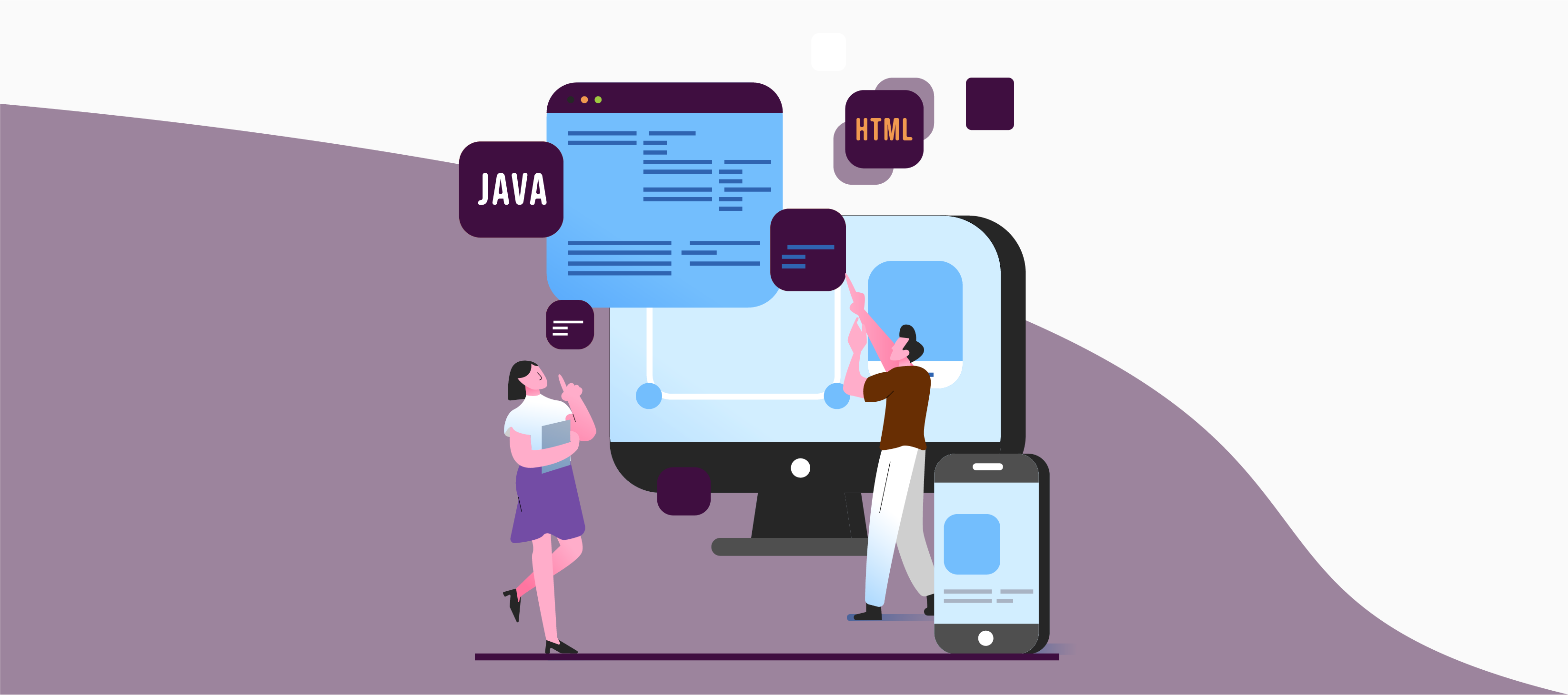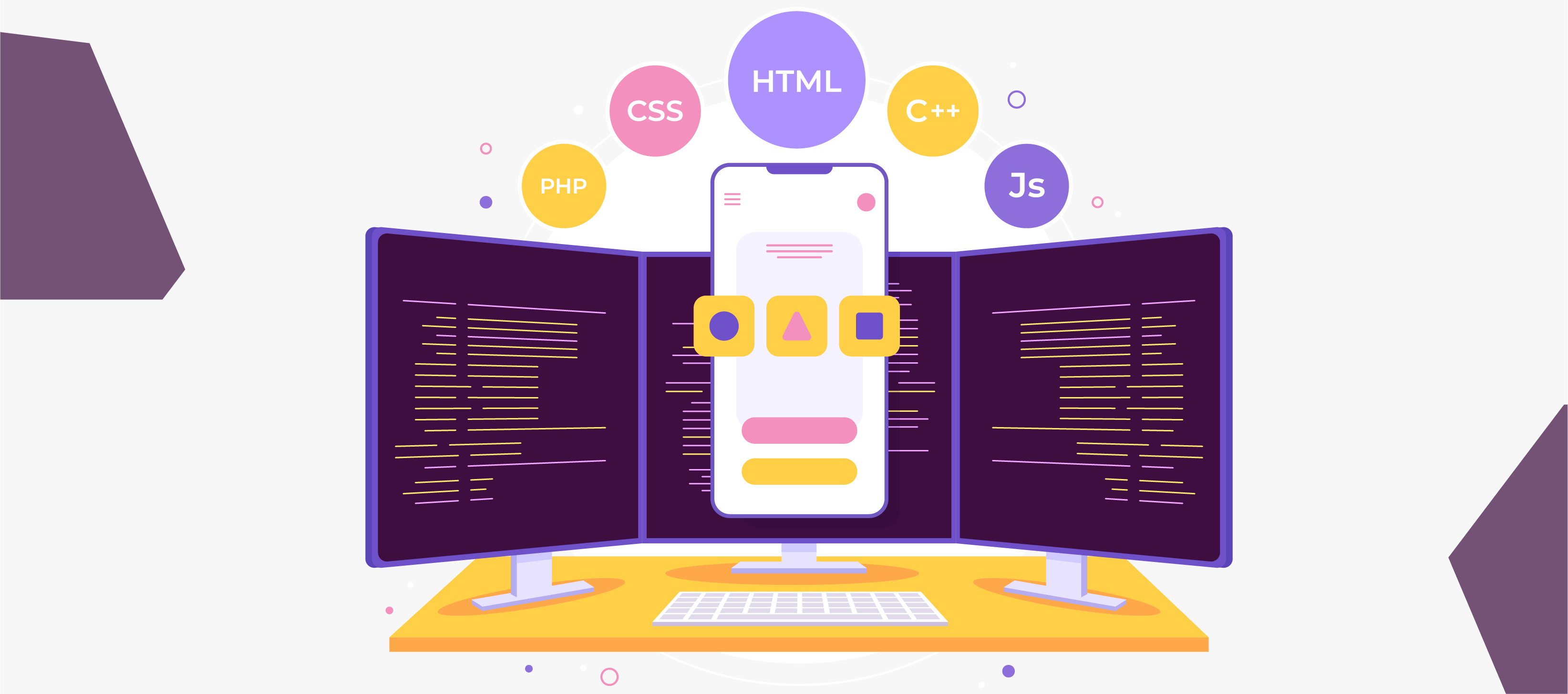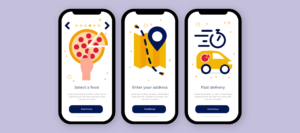In any situation, why should one language be preferred over another? This article will provide a list of coding languages for Web Development that the programmer should select and use to build a website.
Today, computers and other smart gadgets are used for most tasks. Our lives have been faster and more convenient due to the usage of computers and smart devices, not to mention how fantastic the outcomes, productivity, and efficiency have been.
We all utilize one or more social media platforms. And it shows the right information on your screen each time you click a link or navigate through your feed. But have you ever wondered how all of this works?
All of this is made possible by the backend and front end of websites, together with the fantastic user experience. There are programming languages that make using any application a seamless experience for the user. Frontend and backend development are the two main components of web development. The client side and what appears on a screen are served by frontend languages like HTML, CSS, and JavaScript, but the server side or the functionality of a website or app is supported by backend development.
With so many coding languages and framework available, deciding which one to focus on might be difficult. For this reason, we have compiled a list of the 10 top coding languages that will still be in demand in 2023.
Before starting With the best coding Languages for web development, we have also a detailed list of Top Web Development Companies in 2023
Best Languages for Web Development

Are you considering building a website, but you’re not sure which programming language to use? The confusion is understandable – there are numerous languages available. Nevertheless, the languages you need to be familiar with will vary depending on whether you specialize in the front or back end. Let’s examine each of these coding languages for web development in more detail.
Top 5 Backend Coding Languages for Web Development
Let’s first become familiar with the leading backend Web Development languages. Look at these backend languages in charge of data storage and web page functionality.
|
Web Backend languages |
Features |
Year of origin |
| Dynamic Data Type, Lightweight, Divide Server Processing Load | 1995 | |
| Multi-Threaded, Secure, Object-Oriented | 1995 | |
| Cross-platform compatibility, values collection, garbage data | 2000 | |
| Object-Oriented, Platform Independent Language, Python Libraries | 1991 | |
| Clear Error Messages, Fast & High Performance | 1995 |
1. JavaScript –
When discussing web development, the name JavaScript is almost always mentioned. JavaScript is one of the most popular and top-ranking programming languages in the computer industry, according to annual surveys from numerous well-known platforms like Stack Overflow and Octoverse. The fact that the particular language may be utilized for both frontend and backend web development is one of the main causes. The language offers several noteworthy features for backend development, including Client-Side Validation, Dynamic Typing, Interpreted, Object-Oriented programming Support, Lightweight Scripting Language, and many more.
- JavaScript Frameworks for Backend Web Development: Next.js, Express, MeteorJS, etc.
- Popular websites using JavaScript: Facebook, Google, eBay, etc.
2. Java –
Another excellent programming language for developing the backend of a website is Java. Developing enterprise-scale online apps and desktop, Android, scientific, and other applications is frequently done using object-oriented programming languages. The main benefit of utilizing Java is that it operates on the “Write Once, Run Anywhere” principle, meaning that Java code may be run on any platform which supports Java without requiring a new compilation. Platform independence, extensive open-source libraries, automated memory allocation & garbage collection, portability, etc., are other benefits of Java.
- Java Frameworks for Backend Web Development: Spring, Struts, Grails
- Popular websites using Java: LinkedIn, IRCTC, Yahoo, etc.
3. C# –
Microsoft created the object-oriented programming language C# (C Sharp). It was initially designed so that Windows programs could be built using the .NET framework. Today, it is widely utilized in creating mobile apps, games, and backend systems. It will be one of the top coding languages for web development in 2023 since it can be utilized on Android, Linux, iOS, and Windows platforms. The language offers several beneficial characteristics, including component-oriented and structured language, faster compilation, interoperability, scalability, and update ability.
- C# Frameworks for Backend Web Development: .NET
- Popular websites using C#: GoDaddy, Stack Overflow, etc.
4. Python –
While Python is well-known for being compatible with cutting-edge technologies like Machine Learning, the Internet of Things (IoT), Data Science, etc., let us assure you that this amazing programming language is also extensively utilized and ideal for backend web development. Python is one of the three main languages Google uses; the other two are Java and C++. Even one of the major IT giants of the modern era, Google, heavily relies on Python. One of the main benefits of adopting Python for web development is its extensive library of standard libraries, which significantly eases and speeds up developers’ work.
- Python Frameworks for Backend Web Development: Django, Flask, Pyramid, etc.
- Popular websites using Python: Spotify, Pinterest, Instacart, etc.
5. Ruby –
Ruby is a well-liked backend programming language for web development that enables procedural, useful, and object-oriented programming. The language is widely used for web development with the Ruby on Rails framework. Like Python, Ruby focuses on boosting developer productivity, ultimately speeding up the web development process. In addition, let us point out that Ruby is heavily based on many other programming languages, like Perl, Lisp, Eiffel, Ada, etc. This language supports all major platforms, including Windows, Mac, and Linux.
- Ruby Frameworks for Backend Web Development: Ruby on Rails, Sinatra, Grape, etc.
- Popular websites using Ruby: Airbnb, Shopify, Slideshare, etc.
Top 5 Frontend Coding Languages for Web Development
After you’ve read and comprehended the backend languages for Web Development, let’s move on to some of the most often utilized frontend languages:
| Web Frontend Languages | Features | Year of origin |
|
HTML |
Semantic Structure, User Friendly & Simple | 1993 |
|
CSS |
CSS Subgrid, Flexbox Gap, Scroll Snap | 1996 |
|
React |
One-way data binding, Conditional statements, Simplicity | 2013 |
|
Angular |
High Speed & Optimum Performance, Less Code Framework | 2009 |
|
TypeScript |
Object-oriented language, TypeScript supports JavaScript libraries | 2012 |
1. HTML –
HTML is the common markup language used for creating documents that will be viewed in a browser for the Internet. Every web page you visit on the Internet was created using HTML in some capacity. To instruct your browser on how to show the information or load different elements, HTML code ensures the usage of various elements, including text and graphics. A website is a document usually created in HTML code and interpreted by a web browser. By providing a URL, you may identify any type of web page, static or dynamic. Documents, buttons, tags, lists, and other items are examples of attributes in HTML.
- HTML Frameworks for Frontend Web Development: Bulma, Bootstrap, Foundation
- Popular websites using HTML: Amazon, Wikipedia, Twitter, LinkedIn
2. CSS –
CSS is yet another excellent frontend language. It was created for the first time in 1996, one year after JavaScript, by the W3C. The language known as CSS, or Cascading Style Sheets, is used to style a website’s text, color, buttons, and tables and control how its pages are organized. It is a web design tool for transforming a document into a usable format for audiences. This is important since browsers like Chrome, Edge, and Firefox were designed to graphically transmit content to screens, projectors, and printers.
- CSS Frameworks for Frontend Web Development: Bootstrap, Foundation, Skeleton
- Popular websites using CSS: Pinterest, Reddit, Tumblr, Spotify
3. React –
One of the most well-known coding languages for web development is React, built on a JavaScript framework by Facebook. This open-source library was first made available in 2013. It is currently one of the most used JavaScript libraries for building web front ends. It is appropriate for designing visual user interfaces and presenting data for browsers, so it has attained widespread use. React enables you to create complex user interfaces (UIs) out of even the smallest, most isolated pieces of code, or what are known as “components.”
- React Frameworks for Frontend Web Development: Material UI, React Bootstrap, Atomize
- Popular websites using React: Facebook, Instagram, Netflix, etc.
4. Angular –
Angular is a TypeScript-based open-source JavaScript framework. One of its key objectives is to create single-page apps that Google runs. As a framework, Angular has obvious benefits and gives a consistent framework for programmers to work with. It enables users to easily manage the large apps they create.
- Angular Frameworks for Frontend Web Development: Suave UI, PrimeNG, UI Bootstrap, etc.
- Popular websites using Angular: Google, Microsoft Xbox, Paypal, etc.
5. TypeScript –
Microsoft developed TypeScript, an open-source programming language, in 2012. TypeScript is a superset of JavaScript and may be used on the front or back end, much like JavaScript. The main advantage of TypeScript is that it enables JavaScript to have optional static typing, classes, and modules added so that it may be utilized in the creation of huge applications. Additionally, TypeScript enables programmers to identify typical problems early in the development cycle, speeding up JavaScript development.
- TypeScript Frameworks for Frontend Web Development: NestJs, FeatherJS, LoopbackJS. AdonisJS
- Popular websites that are using TypeScript: Slack, DoorDash, etc.
How to Choose the Best Coding Language for Web Development

When selecting which web development language to use, there are three questions you should ask yourself.
Question 1: Which Is the Easiest Programming Language to Use?
Depending on your experience level, you can choose the coding languages for web development that is the simplest to use. If you have any familiarity with a simple language like HTML, you have a simple understanding of syntax and layout. However, some web programming languages are more straightforward than others. You should choose a structured, short language that provides libraries and frameworks for ease of use.
Question 2: What Is the Most Popular Web Programming Language?
When choosing the best coding languages for web development, popularity is important. Java, JavaScript, and C# are a few popular coding languages for web programming.
Question 3: Which Platforms Do You Utilise?
The most prevalent operating systems are Windows, macOS, and Linux. However, Chromebooks are becoming more and more popular. If you’re implementing a language like C, you must use a compiler that works on Linux and Windows machines. Users of macOS must either use Xcode, dual boot with a suitable OS or utilize a virtual machine (VM).
Final Remarks
As a result, more coding languages for web development can be used , but we’ve listed the most valuable and highly recommended languages for backend and frontend web development that you might use to develop a website. However, before selecting any of the languages mentioned above, you must evaluate various factors such as your goals, project needs, learning curve, and so on.
FAQs
Question 1: What exactly does ‘development’ mean in the context of web development?
Designing a website and using backend code are both aspects of web development. The objective is frequently to create a database-driven site that enables dynamic content updates. Whether you require a straightforward catalog site or a sophisticated eCommerce platform, Pairroxz Technologies creates solutions tailored to your business needs.
Question 2: How much time does it take to complete a website?
The timeline is determined by the number of pages and their complexity. Typically, a site with 5–10 pages takes 3–10 days to complete, assuming we promptly receive the required information from the client.
Question 3: What distinguishes web design from web development?
Constructing a website is known as web design, but web development adds interactive and dynamic features. Web development and a database-driven website are necessary if your site must constantly update or interact with users.
Question 4: What is the cost of a website?
The requirements of each specific project determine the cost of a website design. Well, the average cost to build a website is $15,000 -$150,000
Question 5: Will my website work on a mobile device?
Absolutely! More than ever, having a mobile-friendly website is essential! We put a lot of effort into ensuring your website looks fantastic on several devices.

![10 Best Coding Languages for Web Development in 2023[New Guide]](https://pairroxz.com/blog/wp-content/uploads/2023/06/10-Best-Coding-Languages-for-Web-Development-in-2023.png)



